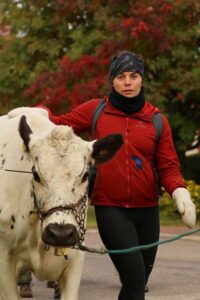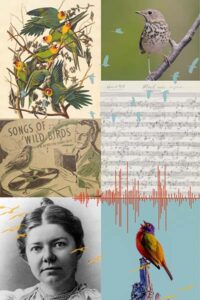This panel presentation, held as part of the inaugural Earth Fest, consisted of four presentations from faculty and students.
On Posthuman Soundscapes and Nuclear Futures
Gabrielle Cornish, Assistant Professor of Musicology
What does nuclear disaster sound like? Following the reactor explosion at the Chernobyl Nuclear Power Plant on April 26, 1986, Soviet scientists measured the radioactive fallout not by sight, but by sound: the clicks of Geiger counters alerted them to invisible danger. These inauspicious pops, named the “smallest voice known to science” by one commentator in the New York Times in 1929, have come to give voice to our greatest fears in the atomic age.
Some musical representations, like Krzysztof Penderecki’s Threnody for the Victims of Hiroshima (1961) and Alfred Schnittke’s Nagasaki (1958), approach the atomic age by bearing witness to the horrors of the United States’ attacks on Japan. Others, like Hildur Guðnadóttir’s score to the 2019 HBO miniseries Chernobyl, use field recordings and techniques from musique concrète to “accurately” depicting historical testimony to the horrors wrought by nuclear fallout. While both methods present music scholars with important questions about trauma and memory, we can think, too, of radioactive disaster as a sonic phenomenon in itself.
In this paper, I use the Chernobyl disaster as a starting point to set sound and music studies into dialogue with the “deep history” (Smail 2008; Tomlinson 2015) of radiation and radioactivity. Weaving together archival research, scientific testimony, oral histories, and musical examples, I argue that radiation is itself an agent of sound. I situate the Geiger Counter, a 1928 invention that translates ionizing particles into clicks, as a sonic medium.
Following Timothy Morton (2013), I position radiation as a “hyperobject”: an object that is so vast and immeasurable that it defies interpretation. As something that is both incomprehensible and invisible to the human eye, radiation intersects with audile techniques in ways that can help recalibrate our approach to ecological disaster in the Anthropocene. Ultimately, this paper asks what listening to Chernobyl can teach music studies about our tenuous atomic present — and our ever-encroaching nuclear futures.
Reggae and Rehumanization: Uneven Development and Cultural Production
Elijah Levine, PhD Student, Literary Studies
This paper considers Sylvia Wynter’s theory of ritual rehumanization pursued in the yet-unpublished 1970s monograph Black Metamorphosis, especially its focus on Roots Reggae in the late 1960s and early 1970s. Through a set of interviews with my relative Trevor Beckford, who managed and recorded records in Kingston post-Independence, I consider how practices of epistemic and cultural production against racial capitalism’s violent management of the globe amidst the material changes of the 1960s and 70s are articulated through commodities, records recorded by contingent workers in Jamaica and circulated globally by sound-system owners.

Kulning: Listening for Shapes of Landscape in Scandinavian Herding Calls
Caitlin Vitale-Sullivan, Former UW–Madison Graduate Student
“It is not a song you learn, it is the song you receive of the forest.” This is what Karin Edvardsson Johansson told Maria Röjås, tradition bearer and my teacher, when Maria asked how she learned kulning songs. A vocal technique originating in Scandinavian herding practices, kulning is used to communicate over long distances, to call in herd animals and to frighten away predators.
Because of these uses, the music is determined, shaped, and changed by the landscape itself. Vitale-Sullivan will discuss the role that landscape plays as a musical collaborator in kulning and explore other members of this collaboration – trees, mountains, cows, and herders. She will also discuss the changes that have occurred in this tradition as a result of changing agricultural practices, loss of collectively owned land, and a shift in how traditional music is used.

Singing through Extinction: Multispecies Music-Making through Recorded Birdsong
Allyson Mills, MS Student, Environment and Resources; Calla Ward Olson, PhD Student, Environment and Resources
From the time we first heard birds sing, music-makers around the world have often included birdsong in their music-making processes. For reproducible performances and recordings, this has mainly occurred through imitation of bird calls through vocal and instrumental music, and musical co-creation with live birdsong.
What does this mean as we face biodiversity loss and extinction of many avian species? From 800-year-old western art music to modern experimental soundscapes, this paper questions how future music-making can revive the collective memory of now extinct birds through their recorded vocalizations. Overall, integrating music and birdsong allows us to reflect on humans and birds’ shared expressive lives and provides future implications for multispecies music-making.